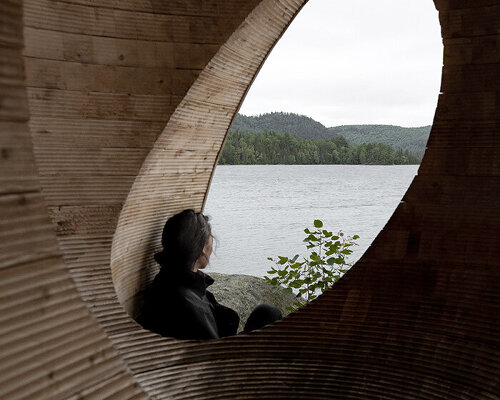‘Faire le Vide’ lands on a Remote Island in quebec
Faire le Vide is a public installation on a Quebec island only accessible by canoe or kayak, designed by Luca Fortin and Atelier mock/up. Conceived as part of a broader initiative to animate the remote islands of Poisson Blanc Regional Park through site-specific interventions, the project establishes a quiet architectural presence in the vast natural landscape.
The structure takes the form of a wooden cube. Its exterior is rational and restrained, while the interior is characterized by sinuous contours and expressive milling texture. Winner of a design competition launched by Poisson Blanc, the project is both an artwork and a place of pause.
Faire le Vide is a cedar installation in Quebec’s Poisson Blanc Regional Park | image © Maryse Béland
the prefabricated structure of laminated cedar
The carved-out cube of Faire le Vide was prefabricated by Luca Fortin and Atelier mock/up off-site, then transported in individual components by boat and assembled manually on the Quebec island. This approach eliminates the need for heavy machinery and preserved the integrity of the rocky terrain. The design team embraced the logistical limitations of the site, allowing them to shape an installation that feels inextricably linked to its context.
The structure is crafted from laminated cedar. Its exterior is clad in vertical slats, echoing the verticality of the surrounding pines. Inside, the CNC-milled surfaces retain the traces of the fabrication process, forming a chamber defined by texture and light. These toolmarks, both functional and aesthetic, ripple across the curved walls to inspire a dialogue between digital fabrication and naturally eroded cliffside below.
the project was designed by Luca Fortin and Atelier mock/up | image © Maryse Béland
contrasting spatial qualities
From the water, Luca Fortin and Atelier mock/up’s Faire le Vide cube appears minimal and self-contained. Its placement, elevated on a rocky rise, allows it to function as a subtle landmark without overwhelming the landscape. The shift from the orthogonal exterior to the sculpted interior is immediate and disarming. As visitors step inside the cedar-scented installation, they enter a compact and disorienting space enveloped by curves and shadows.
Light filters through narrow slits in the cladding, casting thin lines across the interior surfaces. These apertures connect the occupant to the surrounding forest and reservoir without compromising the enclosure’s introspective quality. The interplay of solid and void, smooth and rough, lends Faire le Vide a spatial rhythm attuned to the cycles of the day and the conditions of the weather.
the cube’s expressive interior is carved from CNC-milled laminated cedar | image © Maryse Béland
the installation was prefabricated off-site and assembled manually | image © Maryse Béland
the slatted exterior reflects the verticality of the surrounding forest | image © Irvin Burel
interior surfaces retain the milling toolpaths for textured surfaces | image © Maryse Béland
the shift from the shell to the curved chamber lends heightened spatial awareness | image © Maryse Béland
Faire le Vide explores the relationship between craft and landscape | image © Behind Creation
project info:
name: Faire le vide
architect: Luca Fortin + Atelier mock/up
location: Poisson Blanc Regional Park, Notre-Dame-du-Laus, Quebec, Canada
photography: © Maryse Béland, Irvin Burel, Behind Creation, Luca Fortin, Maika Nadon
The post faire le vide: carved-out cedar cube installation dots remote island in quebec appeared first on designboom | architecture & design magazine.

